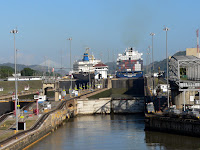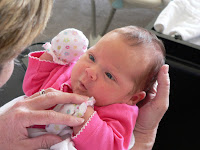 |
| Turning coffee beans to dry out |
March 10 Puerto Quetzal, Guatemala, Central America
Arrived in Guatemala 7am and were pushed into the berth by the tug boats, Amazonas and Hercules. We were on a berth, so no time spent queuing for tenders ashore, and we were off by 8am on a trip to the coffee estate of Finca Filadelphia. As we drove along very good highways past sugar cane plantations, with views across to some of the chain of twenty volcanoes, our guide explained that sugar is the number one export, then coffee, then bananas and Del Monte fruits (from the Atlantic East coast). Some sugar cane production is mechanised, but mostly it is harvested and grown by men. With an average earnings of $200 per month, labour is cheap.
Mainly Roman Catholic, the tendency is to have large families of maybe five children, and not send them to school, because they can help by working in the fields, so illiteracy stands at 25%, with children starting working as young as 8yrs. With a more liberal government, over the last few years, things are beginning to change. There is an encouragement of tourism, Antigua Guatemala has achieved UNESCO World Heritage status, and families are encouraged to give their children breakfast, and send them to school, by a payment of $40 per child per month. Before children would walk 2K to school with empty stomachs, if they went to school at all. The current governing party hav been encouraged by a friendship with Brasil and its successes.
 |
| Typical Bus in Guatemala |
The average person is quite poor, average wage being approx $200 per month, and all the wealth is in the hands of 15 or so families, who own the coffee, amd sugar plantations.
As we drove along, it was explained to us that there were three active volcanoes, which belched smoke into the sky, and one had erupted a couple of years ago, covering towns in ash, and people could see red lava streams flowing down the volcano. Mudslides had claimed the lives of many people in recent years, and the city had had to move its position three times in recent years. In spite of this, the people are very friendly and welcoming ( on leaving, the tourist info rep said to me "I wait for your return"). At the dock, there were two tribal woman, weaving beautiful coloured cloth on a simple loom. It would take them about three months to weave a traditional blouse. The colours used signify which of the 20 or so tribes that woman belongs to, and so they wear their individual blouses with pride. The language is Spanish, but 60% use Mayan dialect. You got the feeling that this was still a developing country, embracing tourism and the change they hope that that would bring. But whilst so much wealth is in the hands of such a small minority, and there is such poverty and illiteracy, it's difficult to see how things can improve in general for the poor.
There was a discreet but high level of security around, with gun-carrying guards on commercial vehicles and around public buildings. (Ian saw such a guard on the back of a pepsi wagon). We'd previously seen guards at the little museum in Zihuantanejo, and it came as no surprise that the number one job for young men is to become a security guard!
Back to Antigua Guatemala, because of its UNESCO status and obligations, shops in the town are not allowed to adverise their wares, and without signage, the town takes on a much older and unspoilt appearance, with its strictly conforming colours of paint, most buildings are painted white, yellow, orange, or blue.
 |
| Church in Antigua Guatemela |
The coffee plantation trip was fascinating, from an awareness of the plant upon which the jasmine-like flowers, and then the red berries of the coffee bean grow, to all the different processes of stripping off the various layers, to washing, drying and rosting the beans. I didn't like to ask if this was fair-trade coffee, but I suspect not. The women do the more manual work of harvesting the beans, and at the end of the process, packaging the coffee, but the men do the technical business of treating the coffee berry, raking and drying the bean etc
We lost another hour tonight, as we worked our way down the coast of Central America, 900 miles to Fuerte Amador, Panama. During the night we sailed past El Salvador, then the following day, past Honduras, and then past Costa Rica, later in the evening, and along the coast of Panama, making one day and two nights for the journey. Makes you realise how far it is! First windy and bumpy day at sea, but comfortable. In the meantime, Japan is hit by an earthquake of 8.9 and a tsunami kills at least 2000 people!!




























